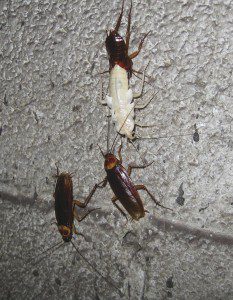Here’s Why Pests Love Your Basement!
By Chris Williams on March 9, 2016.
Why do we always have so many bugs in our basement? Seems like every time I go down there, I see some kind of bug running, so it’s gotten so that I don’t want to go down there anymore. We don’t have insect problems upstairs. L. J., Stratham, NH

Cockroach in Basement
Basements provide several things that insects and other arthropod pests like such as high moisture levels, darkness, food, and probably plenty of hiding places. And unfinished basements, like attics, are rarely disturbed.
Most of the pests that end up in basements are those that require high relative humidity. Outside, they live primarily in soil, mulch, or debris around building foundations. On an upper floor of your home, these pests probably would not survive long due to the drier air. This is why when they end up inside a home, they seek out the dampest areas, usually the basement or crawlspace.
Typical basement pests are pillbugs, sowbugs, millipedes, centipedes, oriental cockroaches, earwigs, silverfish, camel crickets, and spiders. Most of them are scavengers, feeding on decaying organic material and a variety of other items. Others, such as centipedes and spiders, are predators feeding on their fellow basement dwellers.
Dry Them Out, Keep Them Out!
You can eliminate basement pests pretty easily by changing the conditions that attract them.
1. Lower the humidity. Do whatever you can to dry out that space with a dehumidifier, ventilation, space heaters, etc. If you can get the humidity low enough, that alone will kill many basement dwellers. Make sure you don’t have plumbing leaks, or sump pump or flooding problems that are adding to the dampness.
2. Seal up openings. Inspect your basement for places where pests could be entering. Make sure windows and foundation vents are screened and caulk around any openings where pipes, cables, or electric lines enter the house. Make sure basement doors have thresholds or sweeps and seal tightly. Inspect around any window wells for gaps or cracks that should be sealed. Clean leaves and debris out of the window well.
3. Eliminate any food sources. If you store bulk items such as birdseed, dry pet food, grass seed, or root vegetables from the garden in your basement, you are feeding basement pests as well. Don’t store bagged garbage or recyclables in the basement either.
4. Pay attention to the exterior foundation. Having lots of moisture-loving pests in your basement probably means that you have a large population around the perimeter of your home. You can make this area less hospitable by removing or reducing mulch, trimming back heavy vegetation, and removing piles of wood, stone, or debris that are stacked against the foundation.
5. Have an exterminator evaluate the need for pesticide treatment. Contact Colonial about a pesticide treatment for your basement space. You may be able to resolve the problem by completing the steps above and then treating outside only. Spraying around doors and windows will help keep pests out. An exterior perimeter treatment will also eliminate basement invaders before they can move inside. Call Colonial today!
Photo Credit : NY State IPM Program at Cornell University | CC BY 2.0